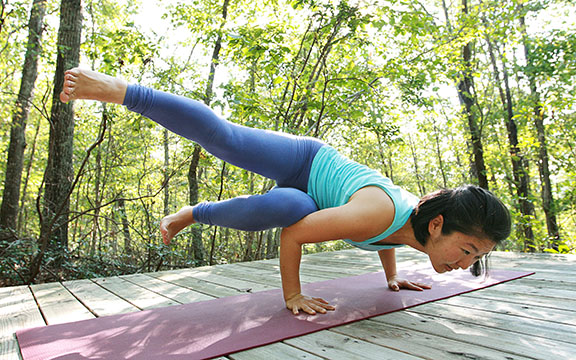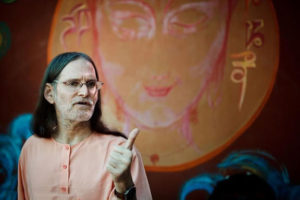 With his unique humor and enormous depth of wisdom, Swami Asokananda is a master in presenting the great teachings of Yoga in ways that are deeply relevant to key issues in modern life. In this article, he shares the benefit of his experience from his personal journey on the mat and in front of a classroom for five decades.
With his unique humor and enormous depth of wisdom, Swami Asokananda is a master in presenting the great teachings of Yoga in ways that are deeply relevant to key issues in modern life. In this article, he shares the benefit of his experience from his personal journey on the mat and in front of a classroom for five decades.
There are different intentions that people bring to Hatha Yoga practice. My personal experience has been that asanas lead me into a higher state of awareness. I’m using the body as a portal, or doorway, to connect with my true Self. It’s good to have some clarity and a stated intention for our practice—not that we can’t have multiple intentions. In my own case, I do want to maintain a flexible, strong, and healthy body, and sometimes I want to address some therapeutic things. But my main intention is to connect more deeply with my Self. The intention of your practice has an impact. If you start your sadhana with a specific goal in mind, it does help you to reach that end.
The main thing I share with students is that asanas are a journey and to really enjoy and pay attention to each moment of the journey. Don’t wait until you have achieved the pose; move into it as a living, organic experience. Feel every moment and with each breath, feel that there’s a shifting of that experience so there’s no time when you say, I’ve reached the end of this asana—you are still traveling in the asana.
A part of deepening one’s practice, as we move from a beginner’s level into a more advanced asana practice, is to look at how we react to resistance we may feel in a posture. If we back away from any sensation that is different and always go to comfort, we don’t find the place where we need to grow. I want my Hatha Yoga experience to be fully enjoyable. A part of that for me means learning to distinguish between the resistance to going deeper vs. the body defending itself and contracting because it’s in pain.
I think we have to develop a healthy relationship with our edge. If we rush toward it, the body contracts. If we ease ourselves toward it, stay with our breath, and listen with great sensitivity, the body will find no cause to offer resistance. We want to respectfully approach what feels like our limit, rather than to bull past it, either due to unconsciousness or aggressiveness. By acclimating to the sensations and relaxing into them, often the edge will shift and we can comfortably move a little deeper into the pose–into the next edge. The distinction I make is one of pain vs. good discomfort. You should be able to breathe comfortably in the asana—use that as an indicator. If you can develop this attunement to your edge, with meditative wakefulness, then your asana practice becomes a living experience and you’ll love it even more.
As my practice has deepened and evolved over the years, I have found it helpful to, once a year or so, find a teacher whom I feel is moving in a direction that feels right to me. Then, I take a workshop or a few classes with that teacher. I think it’s valuable to keep learning and see what others are doing to connect to a higher source. It keeps my practice from becoming stale, and I can learn from that.
The power of asana, for me, starts with practicing with ahimsa and satya. Ahimsa means no violence or harming the body in any way. The first principal of practice and of teaching is: Do no harm. Practicing with satya means to be truthful about where I am in a pose rather than thinking what the pose should be or how it should look. This is the starting point, which leads me to the place where I begin to feel the pranamaya kosha or energy body. When you start to practice from this kosha, you begin to discover your Yoga—it’s not coming from someone else, your teacher, or anything outside of you. The energy is discovering the optimal way to move and you are sensitive enough to pick it up and smart enough to follow it.
There’s a lot of discussion in asana practice about alignment. Alignment usually means that someone, who knows a lot, is helping you find the way to stack bones, ligaments and muscles so that your prana flows most freely. I define alignment as the place where your prana flows optimally. The Integral Yoga approach says that we find the place where we’re in touch with the prana and we let the prana align the body so it flows most freely from the inside out. We ask ourselves, “How is my energy flowing? What do I need to do to respond to how the energy feels?”
In terms of teaching Hatha Yoga, each school will have a different idea of the best ratio between details given and quiet time. Many Yoga teachers feel they are teaching when they are speaking, but, in Integral Yoga, a lot of the teaching is in how we use the silence so that people can feel what’s going on. If I’m being constantly told by the teacher, “Do this and do that,” and focusing on one part intensively, I’m missing the rest of my body. By skillfully parsing out information, we allow the mind of the student to move inward. I believe that this is teaching in the highest sense—you are helping people discover their own true Yoga.
I was taking class at our Integral Yoga Academy. I was obediently following the instruction of the teacher. Then, the teacher became quiet. My mind also quieted down, and I found just the right place for that asana for me at that moment. That’s what a good teacher does—helps the student find the expression of that asana, in that body, at that moment. Find the right talk-silence ratio that allows space for inner exploration. I don’t want to sound too rigid or critical about studios that play music in class. I occasionally teach a class with music. But we don’t want to distract from the meditative, inward experience of the practice.
Ultimately, the time on my mat is only a training session. It’s the place I gain the learning I need to help me move about my life with awareness. I don’t want to diminish the benefit of asana practice as a preparation for meditation. There’s no doubt a regular, heartfelt practice of asana and pranayama will let you sit still and comfortably for your meditation. The nice thing about being in touch with the inner energy in an asana is that it also brings quietness to the mind for the freest flow of energy, and helps us stay in the present moment. That’s a powerful meditation technique in itself. Then, when you get up off the mat, you don’t have to stop that. You can go out, do your daily activities and they really become Karma Yoga, because you are not generating more karma by your ego getting lost in what you are doing.
I travel all over the world, and I think there’s really something unique about Integral Yoga teachers. There’s something special about a teacher who is able to quiet the ego and understand that it’s their connection to the Whole that brings the most beautiful experience to the class. I still feel my ego come in when I teach or train teachers, but, I also try to stay connected to the truth that teaching Yoga is not about me wowing my students and knowing that, when I stay connected, something can come through that will bring a great experience to everyone, including me.
When you teach, it seems you are the most powerful person in the room. You are telling people what to do, how to move and they follow your instruction. It’s not a surprise that the ego would feed off that, but there’s something in the way the Integral Yoga teachers are trained—the foundation is there so that, if there is any power flowing through them, it’s used to empower the students. If my motive for teaching is to get love and approval from my students, my students will get stuck at a certain place and so will I.
Some teachers feel threatened when their students grow. Swami Satchidananda (Sri Gurudev) was so beautiful and inspiring to us because he always said, “I will be happy when my students surpass me.” It’s human to need love, approval and recognition, but the classroom is not a good venue for achieving this. When we teach, it’s about the students’ needs and creating a safe and supportive environment where their needs get met.
I really love and revere Gurudev’s teachings and approach to Hatha Yoga. A main specialty of the Integral Yoga method is to make sure the eight limbs of Ashtanga Yoga stay together. When we practice asana and pranayama we include the yamas, niyamas and pratyahara. Even in Yoga Nidra you have an experience of dharana, dhyana and maybe even samadhi. Hopefully more and more schools will guide their students toward the rest of the limbs of Yoga and not leave them at asana and pranayama.
About the Author:
 Swami Asokananda, a monk for over 40 years, has the look of an ascetic but the down-to-earth wit that shows his New York City roots and his five decades of study with the great Yoga master Sri Swami Satchidananda. An excellent Hatha Yogi, he helped to develop and facilitates Intermediate and Advanced Integral Yoga Hatha Teacher Training programs, which he has taught to students in many parts of the world. In addition, he is a scholar of the Bhagavad Gita. His popular classes and workshops on this great Indian scripture make it accessible and useful to modern spiritual seekers. He is also the cohost of the popular podcast, “Two Old Fogey Yogis.” Both practical and mystical, Swami Asokananda is one of the most requested Integral Yoga speakers, presenting programs worldwide
Swami Asokananda, a monk for over 40 years, has the look of an ascetic but the down-to-earth wit that shows his New York City roots and his five decades of study with the great Yoga master Sri Swami Satchidananda. An excellent Hatha Yogi, he helped to develop and facilitates Intermediate and Advanced Integral Yoga Hatha Teacher Training programs, which he has taught to students in many parts of the world. In addition, he is a scholar of the Bhagavad Gita. His popular classes and workshops on this great Indian scripture make it accessible and useful to modern spiritual seekers. He is also the cohost of the popular podcast, “Two Old Fogey Yogis.” Both practical and mystical, Swami Asokananda is one of the most requested Integral Yoga speakers, presenting programs worldwide

